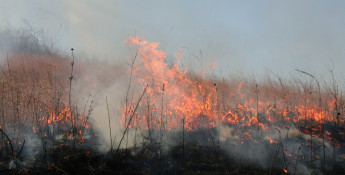By Hannah Becker on February 12, 2018
Prescribed Burning in the Flint Hills of Kansas
Learn how intentional burning helps restore prairie lands

Experiencing the Flint Hills during the months of prescribed burning should be on everyone’s bucket list.
Prescribed burning, also known as a controlled burn, is intentional in the Flint Hills. This method of preservation is used to restore prairie lands to rejuvenate growth and ensure long-term survival.
If you ever get the opportunity to witness a prescribed burn, be aware the experience can be hypnotic.
There’s an intense rainbow of flaming colors, you hear sounds of fire rippling through the dead brush and you can see the concerted teamwork of burn attendees as they carefully coordinate the delicate matter of setting hundreds of acres of fire. It’s quite breathtaking.
When my family first arrived in Kansas, it was early spring – prime pasture burning time. During our first drive through the Flint Hills, we encountered the billowing smoke clouds that many native Kansans know are signs that spring growth is just around the corner. We thought the fiery scene was an accident and asked a fellow rest stop attendee if anyone had called “9-1-1” to report the fire. The Kansan just laughed and said, “You’re not from around here, are ya?”
While prescribed burns may be familiar to most Kansas residents, the reasons behind why they are essential to land management may be less well known.
The History of Prescribed Burns
Agriculture didn’t invent the prescribed burn. Native Americans utilized controlled burns to attract bison herds for hunting, as burning the prairie in the early spring meant more green grass for the bison to graze once regrowth began
Prescribed burns also helped prevent lightning-induced wildfires across the vast and open prairie land (of which only four percent of the original grassland exists today). Following a controlled burn, the charred remains would serve as a firebreak should a thunderstorm leave the fields on fire.
As farmers and ranchers settled the untillable land we now refer to as the Flint Hills, they recognized the ecological value of the historic and natural rangeland management practice of pasture burning.
The Benefits of Prescribed Burns
While we typically think of fire as a bad or dangerous thing, responsible prescribed burning can provide many benefits to our remaining prairies.
Controlled burns allow farmers and ranchers to control weeds chemical-free and help to revitalize the soil through nutrient-rich ash. Without controlled burns, the open prairie would evolve into a cedar-filled forest within just a matter of decades, limiting grazable land required to feed the millions of cattle raised in the United States.
When a pasture is burned during the early springtime, the new growth can get a jumpstart, providing more graze-ready grass for livestock. Cattle grazed on pasture that was burned in the spring actually gain more weight than cattle that aren’t grazed on prescribed burn pasture. In other words, pasture burning allows farmers and ranchers to grow more food while using fewer resources.
Additionally, prescribed burns help control harmful parasites that often reside in old, dead grass. Farmers and ranchers can control parasite levels on their fields, which in turn reduces the chance of illness among their livestock and the wildlife in the area.
The Environmental Effects of Prescribed Burns
Environmental concerns regarding the smoke generated from the spring burns always come up this time of year. Populated areas downwind of the Flint Hills may see evidence of the burn season drift through their neighborhoods in a smoky haze and questions regarding potential health hazards are raised.
To limit disruption in air quality, Kansas State University researchers explored the effects of expanding the prescribed burn season to times of the year beyond April. The researchers conducted a 20-year study at the Konza Prairie Biological Station and discovered that burning pastures in both the fall and winter months continued to provide the soil and vegetation benefits spring burns offered.
Researchers recommended Kansas land managers consider scheduling their prescribed burns outside of the traditional April timeframe. By extending the burn season to months outside of spring, farmers and ranchers can minimize smoke through distribution, maintaining healthy air quality levels throughout the surrounding areas.
Prescribed Burns Help Protect our Prairies
Prescribed burning practices help farmers and ranchers preserve our grasslands for generations to come. This natural rangeland management technique helps to replenish the soil, increase forage production, control harmful parasites and protects our beautiful prairies from invasive overgrowth.
What Mother Nature used to provide through random lightning strikes, farmers and ranchers can continue through carefully planned and controlled land management strategies. Without prescribed burning, we would not have our beloved Kansas grasslands. And what would Kansas be, without her beautiful Flint Hills?
You might also enjoy



